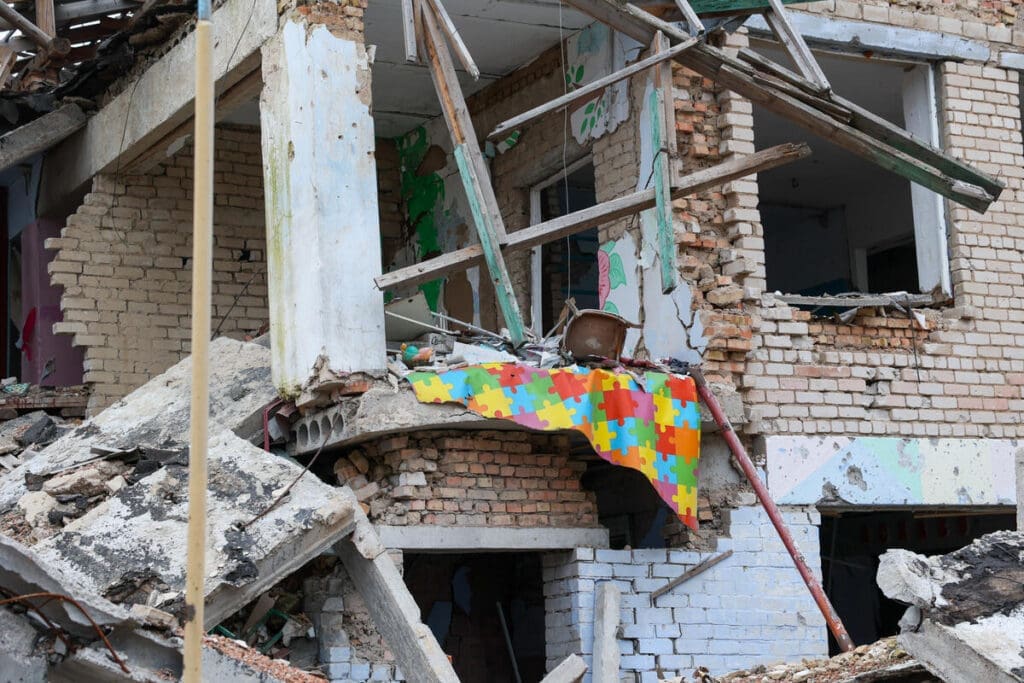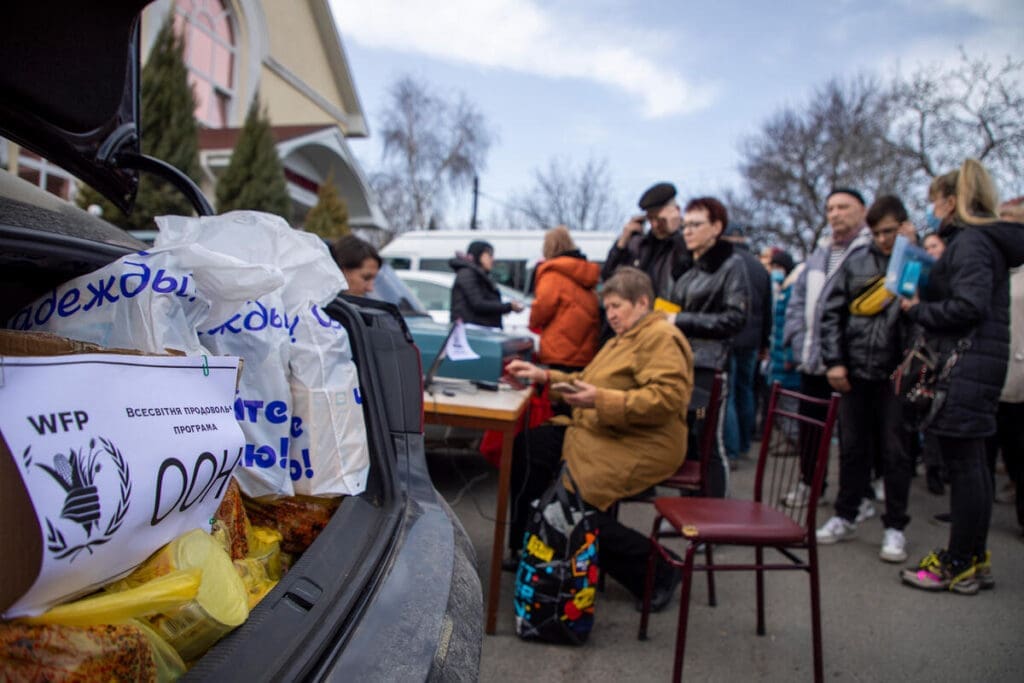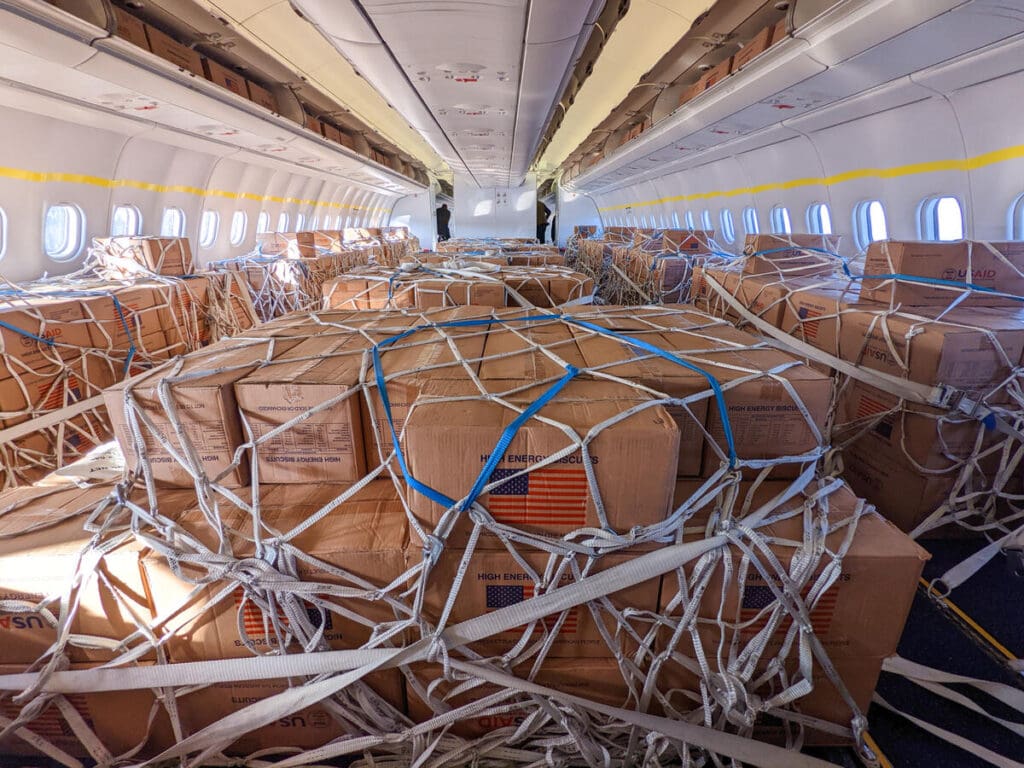One Year of War in Ukraine: How Russia’s Invasion Fueled the Global Hunger Crisis

One year ago, Russia invaded Ukraine and ignited a full-scale war. Since then, the conflict has taken a devastating toll – not only on Ukrainians but on millions of people around the world.
One Year of a Refugee Crisis
Russia’s invasion of Ukraine on February 24, 2022 caused a refugee crisis that is ongoing as millions of Ukrainians flee their homes in search of safety and essentials like food and water. 14 million Ukrainians are currently displaced from their homes: 5.9 million are internally displaced within the country’s borders while 8 million have become refugees across Europe and beyond.
That means one-third of all Ukrainians have fled or lost their homes in just one year.

Ukrainian refugees arrive by the hundreds at a transit center for housing and processing refugees in Hala Kijowska, Poland.
This is the largest displacement crisis since World War II. Many internally displaced Ukrainians have lost their livelihoods, and if they cannot afford or find basic necessities, they will be forced to flee again.
Related Reading
- Learn More About Ukraine
- 7 of the Largest Refugee Crises Around the World
- 6 Current Conflicts in the World Today
One Year of Hunger in Ukraine
The war has destroyed farmland and infrastructure, killed livestock and disrupted vital supply chains – all of which have driven hunger within Ukraine. Today, 11 million people are experiencing hunger – that’s 1 in 3 families. In the worst-affected areas of eastern and southern Ukraine, 1 in 2 families face hunger.
Communities on the frontlines and in areas recently retaken by Ukraine face especially dire conditions. There are no functioning banks, and access to water, gas and electricity is limited. Shortly after the invasion started, the United Nations World Food Programme (WFP) was invited into Ukraine and immediately set up emergency response operations. Since March 2022, we’ve delivered the equivalent of 1.3 billion meals through food and cash assistance. (Learn why the U.N. World Food Programme has to be invited into a country). We reach 3 million people inside Ukraine each month with urgently needed aid.

To boost the local economy, 90% of the food we distribute is purchased from within Ukraine including all bread, wheat flour and sunflower oil. In areas where there are functioning banks and markets, we prioritize cash assistance so people can choose what food to buy for their families.
One Year of Humanitarian Relief in Ukraine
Over the past year, dozens of international aid organizations have supported the people of Ukraine, including eight United Nations agencies.
As one of the largest humanitarian organizations in the world and leader of the Global Humanitarian Logistics Cluster, the U.N. World Food Programme has the operational reach and expertise to respond to emergencies – like the war in Ukraine – within 72 hours. In Ukraine, we led the telecommunications and logistics efforts for the entire United Nations.

Today, we oversee the transportation and storage of humanitarian cargo for 184 partners on the ground in Ukraine. On any given day, we have 50 trucks on the road throughout the country.
One Year of Increased Cost of Goods Around the World
The Black Sea basin is one of the most important areas in the world for grain and agricultural production. Together, Russia and Ukraine are key suppliers of food and fertilizer: The two countries account for 30% of global wheat exports and 20% of corn exports. The war brought shipments out of Ukraine to a standstill. Vital ports were closed while fighting disrupted agricultural production and destroyed farmland. Meanwhile, sanctions on Russian oil and gas drove up energy and transportation costs.
Food, fuel, and fertilizer costs skyrocketed around the world and hunger began to climb in tandem in countries dependent on Black Sea imports.
One Year of a Global Humanitarian Crisis
Prior to the onset of the full-scale war, Ukraine was considered the breadbasket of the world. It produced enough food to feed 400 million people a year – much of it going to famine-stricken regions like the Horn of Africa.
When the invasion began, a Russian naval blockade closed off Ukraine’s ports on the Black Sea, preventing grain from being shipped out. This had a detrimental effect on Ukraine’s economy as well as on countries that relied on the exports to survive.

The WFP-chartered vessel Brave Commander was the first humanitarian cargo vessel to arrive in Ukraine’s Black Sea Ports since the war began.
Ukraine’s ports were closed for six months until a deal was brokered by the U.N. and Türkiye in August 2022 to open grain exports. The deal made specific provisions for the U.N. World Food Programme to ship food to countries that were – and still are – experiencing extreme hunger like Ethiopia, Somalia and Yemen.
The effects of this war have made an already-bad global food crisis even worse, as limited supply and rising costs push millions more people into hunger and starvation.
One Year of Hope, Resilience and Generosity
Despite there being no end in sight to the full-scale war in Ukraine, the resilience of the Ukrainian people – like Nina – and the global humanitarian community keep hope alive:
The war displaced Nina, a young college professor, from her home and forced her to flee without any of her belongings. She heard about a U.N. World Food Programme distribution center where she found not only food but a job. “I was asked if I knew English and if I could help with some translations,” Nina explained. “I did, and then the head of U.N. World Food Programme operations in Ukraine asked if I would join the newly formed office in Dnipro.” Nina now works as a program associate for the U.N. World Food Programme to ensure help is directed where it is needed most.

Nina Yarosh, an associate university professor, fled the bombing in Kharkiv for Dnipro in eastern Ukraine. Now she works as a Programme Associate for WFP’s office in Dnipro.
The generosity our donors continues to fuel our response in Ukraine and in other hunger emergencies around the world. Thanks to our community of supporters, we can deliver food to people in greatest need.
As the conflict enters its second year, there are still 11 million people who need food in Ukraine. Will you help us alleviate hunger in Ukraine and other conflict zones around the world?




